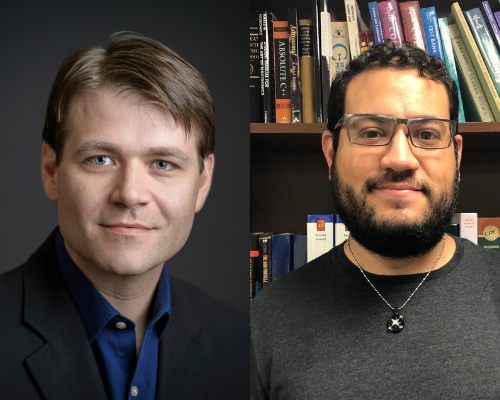Villanova Astrophysicists Receive $854,600 in NASA Grants to Study Structure of Interstellar Magnetic Fields

Dr. David Chuss, left, and Dr. Jordan Guera Aguilera, right
Villanova, PA –Stars are a key part of our origin story. They form out of the large structures of gas and dust that result from the evolution of the universe as a whole and provide environments for potentially life-friendly planets. Along the way, they process the original material of the Big Bang into elements such as carbon and oxygen, without which life could not exist. One of the big mysteries concerning stars, however, is that there are fewer of them than expected. One of the keys to this mystery may lie in the magnetic fields that thread galaxies like our own Milky Way. Astrophysicists have long sought to accomplish a challenging goal—understanding the role and importance of these magnetic fields.
Now, David Chuss, PhD, professor of Physics in Villanova University’s College of Liberal Arts and Sciences, has received three grants from the National Aeronautics and Space Administration (NASA) to study the role that magnetic fields play in the central engine of the Milky Way, and by extension galaxies in general. Jordan Guerra Aguilera, PhD, assistant research professor of Physics at Villanova, has received two additional NASA grants to support research that will also shed new light on magnetic fields and their role in the cosmic story of universe. The combined total of the grants is $854,600, and current and future Villanova undergraduate and graduate students will be involved in the research.
The first grant of $200,000 will support “A Two-Color Polarimetric Survey of the Galactic Center,” with Dr. Chuss as principal investigator, with the goal of revealing the structure of the magnetic field that permeates the central 100 parsecs (300 light years) of the Milky Way in higher resolution than ever before.
The second grant of $300,000 will support “Testing the Predictions of RAT Theory in Star Forming Clouds”, with Dr. Chuss as principal investigator in collaboration with Northwestern University. Researchers will utilize multiwavelength observations from the Stratospheric Observatory for Infrared Astronomy (SOFIA) to test the physics of how microscopic dust grains in interstellar space align with ambient magnetic fields—which will assist in interpreting results from maps that trace the magnetic fields in the interstellar medium to reveal their role in the process of star formation. A third grant of $7000, with Dr. Chuss again as principal investigator, will support a related project, “Deciphering the Radiative and Magnetic Environment of the Sagittarius B2 Molecular Cloud”.
Dr. Guerra Aguilera is principal investigator on the fourth and fifth NASA grants. The first is a $296,000 grant for “Statistical Study of the Magnetic Field Structure in Molecular Clouds of the Gould Belt” The project combines archival data sets from NASA’s SOFIA/HAWC+ with sophisticated modeling with the goal of increased understanding of both how to extract magnetic field information from thee data sets and an improved estimate of the magnetic field strength in each of the star forming regions of the nearby Gould Belt. The second grant, which totals $51,600, will support his related project, “Mapping Large-scale Magnetic Fields in the Gould Belt.”
An expert in the field of astronomical polarimetry, Dr. Chuss received his PhD from Northwestern University. A solar physicist and space scientist, Dr. Guerra Aguilera received his PhD from The Catholic University of America.
About Villanova University’s College of Liberal Arts and Sciences: Since its founding in 1842, Villanova University’s College of Liberal Arts and Sciences has cultivated knowledge, understanding and intellectual courage for a purposeful life in a challenging and changing world. With more than 40 majors across the humanities, social sciences and natural sciences, it is the oldest and largest of Villanova’s colleges, serving more than 4,500 undergraduate and graduate students each year. The College is committed to a teacher-scholar model, offering outstanding undergraduate and graduate research opportunities and a rigorous core curriculum that prepares students to become critical thinkers, strong communicators and ethical leaders with a truly global perspective.
